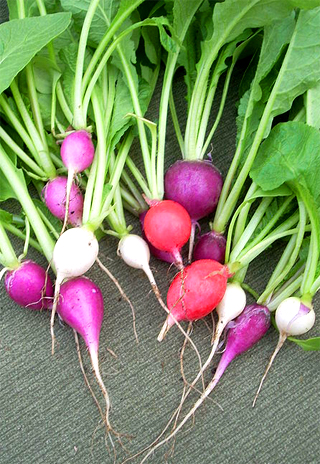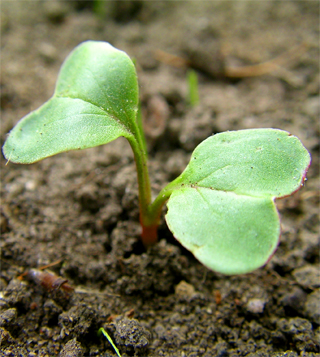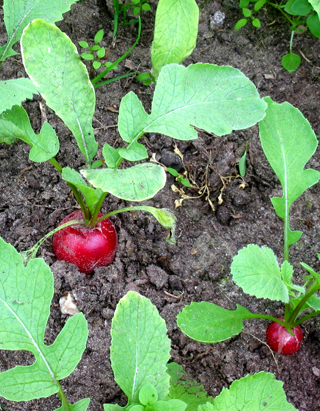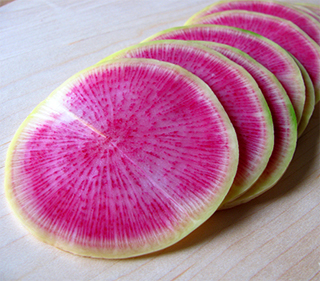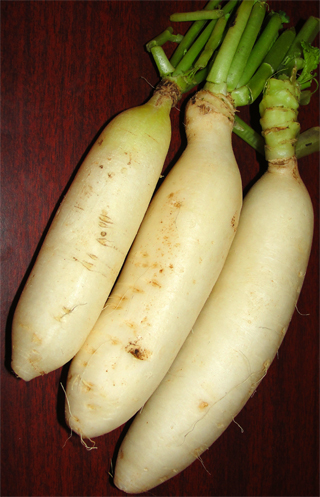
How to Grow Radishes in Oregon, Washington and British Columbia
The garden radish is an easy-to-grow, cool weather crop originating in Asia. Cultivated for several thousand years, it is said to have been a favorite in ancient Egypt and Greece. The fleshy, slightly spicy taproot is usually eaten raw, but can also be steamed or sautéed.
Grown best in cool spring and fall weather, the longer days of summer will activate seed stalk growth and turn the otherwise crispy root pithy and hot tasting.
A number of varieties are now available and fun to experiment with: round, oblong, tapered, red, white, pink and even black cultivars are among modern gardeners’ choices.
One of the fastest maturing vegetables for the garden, radishes can go from seed-packet to table in as little as 25 days. Over-wintering types take longer to mature, coming in at 45-60 days.
Too spicy for you? Try Daikon types like Minowase or Bora King. These sweet, juicy and very mild roots are best sown from June through August.
Radishes and Your Health
- Radishes are a good source of vitamin C and help to rebuild tissues, fights disease and protects our cells from the onslaught of destructive free radicals.
- Radishes are low in calories (just 9 calories in a half-cup) and high in fiber and water content – the perfect diet food.
- A natural diuretic, radishes help purify the kidney and urinary systems and relieve inflammation.
- Radishes are a natural decongestant and anti-inflammatory.
- Like other brassicas, radishes contain compounds that help protect cells from cancer-causing genetic mutations.
- Radish tops and seed pods are even higher in nutrients than the roots.
Seasonal To-do List
Spring
- Direct sow as soon as the ground can be worked. Continue sowing a half row or so every two weeks.
- Thin carefully, crowded plants won’t make bulbs. Thin the first planting when leaves are 2”-3” tall, eating the thinnings if desired.
- Continue planting until warm temperatures promote bolting, around early July in the PNW.
- Keep soil well watered. Radishes will get tough and hot if the soil dries out.
August
- Sow heat tolerant Daikon radishes.
Fall
- Radishes can be planted in a coldframe in September and October.
- Begin harvest of winter crop.
- Mulch over with straw in severe cold.
- Pull aside straw to harvest as needed.
Location
Any sunny site with reasonably good soil should do. Any well-drained loam in full sun will work to grow radishes. Radish seed can also be intermixed with crops such as carrots, beets and lettuce and will serve to mark the rows until the slower growing plants emerge. Radishes also make a good under-planting between rows of broccoli and cabbages.
Soil Prep
Moderately fertile soil is fine for radishes. Compost worked into the top two or three inches of soil should be adequate. Incorporate moderate amounts of finished compost, but avoid over-using commercial-fertilizer, which will cause prolific tops and knotty roots.
Planting
Sow seed 1/2″ deep and thin to 2″. Space rows about 10″ apart. Thinning promptly is essential as crowded plants won’t even make a bulb. Dry soil and crowded conditions will also make roots hot and pithy. Radish tops and seed pods are edible and nutritious and seedlings are excellent in salads.
Make small sowings every few weeks for a steady supply throughout the spring and summer.
Water
Radishes have a shallow root system so water often. Sweet and tender bulbs are produced when the soil is kept moist.
Harvest
Old roots tend to be overly hot and tough with a tendency to crack. Harvest while young (4-6 weeks) and you’ll enjoy radishes at their crunchy, peppery best. Winter radishes can be left under their straw-mulch blanket and harvested as needed or they can all be pulled mid-fall and stored in boxes of clean sand.
Insects and Diseases
While radishes are essentially disease free the are a couple of troublesome insects:
Flea beetles seem to love radish seedlings. Smaller veggies like radishes are a perfect candidate for floating rows covers. These lightweight fabrics keep bugs out while letting in light and rain water in.
Root maggots are also happy to take a chomp out of your radishes and row cover will stop them as well.
An 8″ band of sawdust over your row of radishes will prevent the root maggot fly from laying eggs on the soil surface.
Pyrethrin and Neem oil spray are somewhat effective against both these insects.
Covered, sprayed or banded with sawdust your best defense is always to harvest as early as possible.
